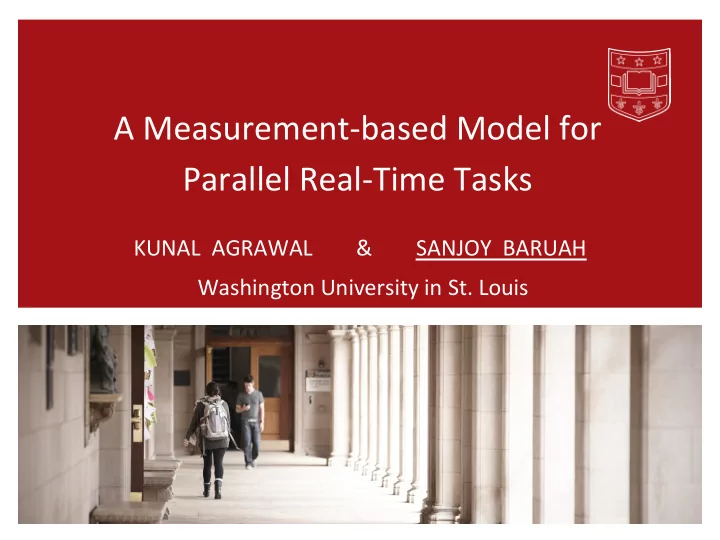

A Measurement-based Model for Parallel Real-Time Tasks KUNAL AGRAWAL & SANJOY BARUAH Washington University in St. Louis
Current models for parallel real-time workloads Graph based : < graph G = (V, E); relative deadline D; period T> Vertices ≈ sequential code; edges ≈ dependencies - Fork-join tasks – a layered graph - Sporadic DAG task – any acyclic graph - Conditional DAG task – add conditional constructs current models – proposed model – algorithms
Current models – shortcomings Graph based : < graph G = (V, E); relative deadline D; period T> 1. Analysis requires knowledge of DAG structure - may not be available/ known 2. Conditional tasks: many possible behaviors - Exhaustive enumeration yields exponential-time algorithms 3. Conditional tasks: worst-case behavior may be very rare current models – proposed model – algorithms
Proposed model – background Proposed model Federated scheduling: each (high-util.) task gets exclusive access to some processors work and span parameters of (regular) DAG tasks - work : cumulative WCET of all vertices (on a single processor) - span : maximum sum of WCET’s of chain of vertices (on infinitely many processors) Response time upon m dedicated processors The list scheduling guarantee - a 2-approximation current models – proposed model – algorithms
Proposed model Federated scheduling . Run-time dispatching using list scheduling IDEA I. Represent each task by its ( work , span ) parameters IDEA II. Measurement-based : work, span values obtained via measurement experiments – profiling run-time behavior (as in probabilistic WCET ) work – upon a single processor span – upon a large number of processors IDEA III. Two pairs of estimates ( work H , span H ) are very conservative estimates ( work L , span L ) are less conservative estimates For efficient implementation, assume that ( work L , span L ) values hold Guarantee correctness if ( work H , span H ) values hold current models – proposed model – algorithms
Proposed model – scheduling algorithms # processors time current models – proposed model – algorithms
Proposed model – scheduling algorithms PROPERTIES 1. Safety is guaranteed (provided preprocessing succeeds) 2. Efficiency : expect m L processors to be used “almost always” - The other ( m – m L ) processors may be asleep/ execute less-critical workloads 3. Dynamically tunable : m L and D L may be recomputed during run-time # processors time current models – proposed model – algorithms
Summary Task models that expose intra-task parallelism • Shortcomings of current models Proposed model ( work , span ) characterization of DAGs + measurement-based estimation of parameters + multiple estimates of each parameter A scheduling algorithm that guarantees correctness and aims for efficiency and is tunable during run-time
Recommend
More recommend